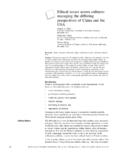Transcription of Running Head: A QUALITATIVE ANALYSIS OF …
1 Running Head: A QUALITATIVE ANALYSIS OF factors contributing TO ethical MUNICIPAL GOVERNMENT A QUALITATIVE ANALYSIS OF factors contributing TO ethical MUNICIPAL GOVERNMENT By Elizabeth J. Webb Montana State University Completed in partial fulfillment of the requirements for EDCI 507 QUALITATIVE Research Methods Dr. Elisabeth Swanson April 30, 2012 A QUALITATIVE ANALYSIS OF factors contributing TO ethical MUNICIPAL GOVERNMENT 1 A QUALITATIVE ANALYSIS of factors contributing to ethical Municipal Government Introduction Background In today s polarized political environment, it is commonplace to open a newspaper and discover a story highlighting the ethical violations of an elected official or government employee. Ethics news stories quickly gain national, and occasionally, international attention. Examples have included ethics investigations into campaign practices, public employee s use of personnel to perform manual labor on private property during work hours, accepting gifts that could influence decision-making, and using public office for private gain.
2 Public mistrust of government is at a record high, the tea party is demanding a smaller and more efficient government, and procedure hawks are challenging government decisions through litigation. The perception of compromised ethics is a significant obstacle to small municipal governments in delivering essential services effectively. Issues facing local government will continue to grow more complex as a result of a devolving federal system, changing demographics, economic hard times, and declining resources and revenues. A Pew Research Center (2010) study reported that Americans are less positive and more critical of government than in the past. Paralyzing partisan politics, public discontent, an on-going economic recession, and criticism of Congress and elected officials are all contributing to distrust in government. The study revealed that just 22% say they can trust the government in Washington and 51% now see the impact of their local government as positive, down from 64% in 1997 (Pew Research Center for the People & the Press, 2010).
3 A QUALITATIVE ANALYSIS OF factors contributing TO ethical MUNICIPAL GOVERNMENT 2 Ethics programs The 2007 National Government Ethics Survey, along with supplemental research reports completed by the Ethics Resource Center in 2010, introduced areas for risk management in the ethics arena. Research has shown that well-implemented ethics and compliance programs double reporting and lower the rate of misconduct (ERC, 2008). In its research on the impact of codes of conduct on corporate culture (LRN, 2006) the report finds that managers and employees make countless decisions that are based on the code. Three out of four people who work at an organization with a written code say that their code helps them understand the behaviors that are valued by the organization. More than eight out of ten employees apply their understanding of the code frequently on the job.
4 However, the mere existence of an ethics program does not imply that it is effective (Mitchell et al., 1996). Effectiveness is determined by the manner in which it is developed, implemented, and embedded, along with the content and quality of each component (Kaptein & Schwartz, 2008). Ethics training West & Berman (2006) note that roughly 64% of cities in the USA offer some form of ethics training, although only 36% call it ethics training. Training provides managers with leverage to attain ethics goals. It is associated with fostering organizational cultures of openness, accountability, and performance that are in turn associated with increased employee productivity. Training also helps employees apply ethical concepts to their real-life work situations and identify strategies for dealing with ethical dilemmas. Trevino et al. (2001) discusses that if employees are aware of ethical and legal issues, they will be more likely to ask the right questions and do the right thing when faced with an ethical dilemma.
5 Employees can do the A QUALITATIVE ANALYSIS OF factors contributing TO ethical MUNICIPAL GOVERNMENT 3 wrong thing simply because they are unaware or do not know where to go for assistance on difficult matters. Maesschalck (2004) notes a continuum between compliance and integrity which should guide ethics training development in the public sector. Compliance involves external controls on the behavior of public servants and often involves rules that employees choose to follow (right) or not (wrong). The integrity approach involves internal controls including moral judgment and moral character. This continuum points to the need to develop training programs that educate on codes of ethics and rules, as well as interactive training sessions to stimulate moral character and improve ethical decision-making. Berman & West (1994) had a similar perspective to Maesschalck.
6 Training is shifting from minimizing wrong doing to building trust among employees and customers of public services. Additional research (Klugman et al., 2006; Frisque & Kolb, 2008) indicates that training does not change employee s values, but increases critical thinking and appreciating others viewpoints, and heightens awareness of ethical issues and increases mindfulness of an employee s own behavior. Weber (2006) discusses what Duquesne University learned about their ethics initiative; that a commitment to ethics must be deeply embedded into the culture, that there must be widespread communication about the ethics initiative, that the training and leadership be centralized, that there is ownership among faculty and students, and that the program must be continually improved and updated. Jovanic & Wood (2008) assert that ethics training cannot take place just once in a training room, but needs on-going support at all levels of the organization.
7 The training should include what ethics is, along with actual examples of relevant situations, and how to explore an ethical dilemma through interacting with others. Frisque & Kolb (2008) underscore the importance of post-training support as a critical step in maintaining learned behaviors. A QUALITATIVE ANALYSIS OF factors contributing TO ethical MUNICIPAL GOVERNMENT 4 ethical culture and climate The organizational culture in which behavior takes places is gaining more attention in ethics discussions. The Ethics and Compliance Officer Association (ECOA, 2011) funded a research report that reflects the need to create a positive ethical culture, so that the broader environment does not fill the void in the absence of that direction. A strong ethical culture increases reporting and cuts misconduct in half (ERC, 2010). When both a well-implemented ethics and compliance program and a strong ethical culture are in place, misconduct drops by 60% and reporting rises by 40% (ERC, 2008).
8 A study of an ethics initiative in City of Denver (Jovanic, 2007) was conducted to determine how talking about ethics contributes to an ethical culture. The Denver study points to the need to include a variety of interventions to address ethical culture from a systems and communications perspective. Additional research (Trevino et al., 1999; Trevino et al., 2001) connects positive ethical cultures to lower rates of observed misconduct, higher rates of reporting misconduct to leadership, reduced pressure to compromise standards, greater satisfaction with management s response to misconduct, greater satisfaction to the organization as a whole, lowered exposure to situations involving misconduct, and an increased sense of preparedness to handle situations inviting misconduct. ethical leadership The Ethics and Compliance Officer Association (ECOA, 2009) research report highlights the primary role that leaders play in the creation of the culture and climate (through modeling, coaching, and communication).
9 The leader s ability to promote ethical conduct is critical in defining doing what is right within the organization. The best ethics program will not create an ethical culture if management implemented the program to protect themselves from blame (Wah, A QUALITATIVE ANALYSIS OF factors contributing TO ethical MUNICIPAL GOVERNMENT 5 1999). Employees need to hear supervisors talk about ethics and act in ways that model ethical behavior. Managers and employees who are informed by ethics have an added edge because they are more likely to know the right thing to do, to undertake those actions, to justify actions on the basis of professional and moral criteria, and to protect themselves from being blindsided by allegations of ethical impropriety (West & Berman, 2006). These are critical competencies for today s managers. Managers who act without regard to professional ethics risk their careers, the reputations of their local governments, and risk losing the public trust.
10 Context It is unfortunate that within the current climate of mistrust in government, the National Government Ethics Survey (ERC, 2008) demonstrated that misconduct in government is very high. One in four government employees works in an environment conducive to misconduct. Strength of ethical culture in government is declining while pressure to commit misconduct is growing (ERC, 2008). Local governments across the USA provide essential services to the public which include water and sewer systems, police, fire, and libraries. When the public lacks trust in their local elected officials, it is difficult to provide these services effectively. Raising rates to cover costs becomes suspect, and a pro-active approach to planning in municipal government is challenging when officials motives are questioned at every step. Effective ethics programs that reduce misconduct, along with the establishment of strong ethical culture and ethical leadership, may be part of the solution to the rift between public perceptions of mistrust and providing essential government services.








